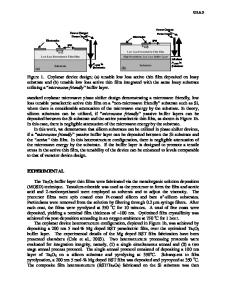Investigations of Pb x Sr 1-x TiO 3 Thin Films and Ceramics for Microelectronic Applications
- PDF / 327,754 Bytes
- 6 Pages / 612 x 792 pts (letter) Page_size
- 45 Downloads / 539 Views
D3.36.1
Investigations of PbxSr1-xTiO3 Thin Films and Ceramics for Microelectronic Applications M. Jain1, Yu.I. Yuzyuk2, R.S. Katiyar1, Y. Somiya3, A.S. Bhalla3, F.A. Miranda4, and F.W. VanKeuls5 1 Department of Physics, University of Puerto Rico, San Juan, PR-00931, USA 2 Faculty of Physics, Rostov State University, Zorge 5, Rostov-on-Don, 344090, Russia 3 Materials Research Institute, The Pennsylvania State University, University Park, PA 16802, USA 4 NASA, Glenn Research Center, Cleveland, OH 44135, USA 5 Ohio Aerospace Institute, Cleveland, OH 44142, USA ABSTRACT We have investigated electrical and optical properties of the lead strontium titanate {(PbxSr1-x)TiO3 or PST} ceramic and dielectric properties of the thin films of PST at low and high frequencies. (PbxSr1-x)TiO3 compositions with x ≤ 0.4 are paraelectric at room temperature and exhibit ferroelectric phase transition below room temperature. Only one phase transition in the PST system (compared to three in BaxSr1-xTiO3) was recorded. The studies indicated that PST has potential for tunable microwave devices in the paraelectric phase. In the present studies, Pb0.3Sr0.7TiO3 (PST30) ceramic was prepared by the conventional solid-state reaction method and thin films of PST were prepared by sol-gel technique. Structural, microstructural, dielectric, and Raman measurements were performed on these samples. Sharp phase transition was observed in case of the ceramic by dielectric and Raman measurements at 283 K. Raman measurements revealed well-pronounced soft-mode behavior below the Curie temperature in PST ceramic. The thin film of PST deposited on lanthanum aluminate substrate was highly (100) oriented and showed dielectric maxima at ~280 K, which was close to that in case of the bulk. Eight element coupled micro-strip phase shifters (CMPS) was fabricated on the PST film and tested in the frequency range of 15-17 GHz. The average figure of merit of 49 o/dB for PST30 film in the Ku band at 533 kV/cm suggests the potentiality of these films for high frequency tunable dielectric devices. INTRODUCTION In recent years, considerable research effort has being directed towards the development of thin ferroelectric films for applications in computer memories (both non-volatile and dynamic random access memories, NVRAM and DRAMs) and tunable capacitors for high frequency microwave devices [1-6]. With the rapid growth of various communication systems, the demand for tunable circuits at RF and microwave frequencies has increased. The ferroelectric perovskite thin films of barium strontium titanate (BST) have been investigated extensively for applications in microwave devices, which include varactors, phase shifters, tunable filters etc [5-8]. However, there is an increase research activity to search other suitable/better ferroelectric materials for such applications. For microwave applications, it is desirable to produce thin films with optimum ratio of tunability and loss tangent (tanδ). The transition temperature of materials is also required
D3.36.2
to be below the
Data Loading...










